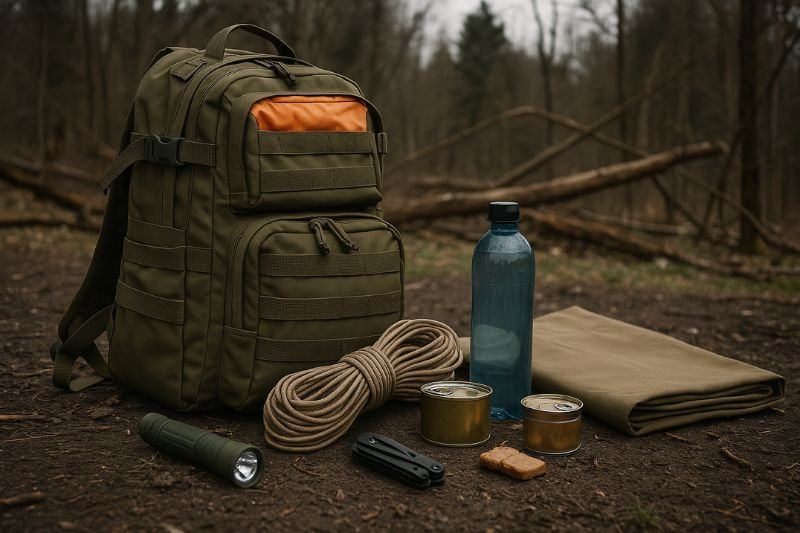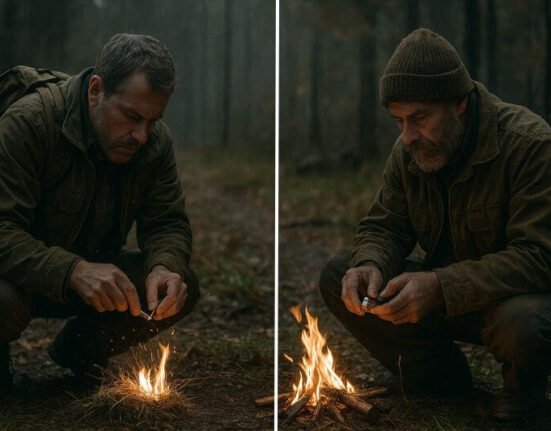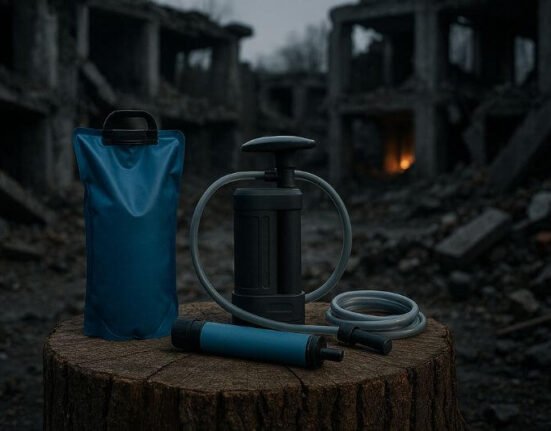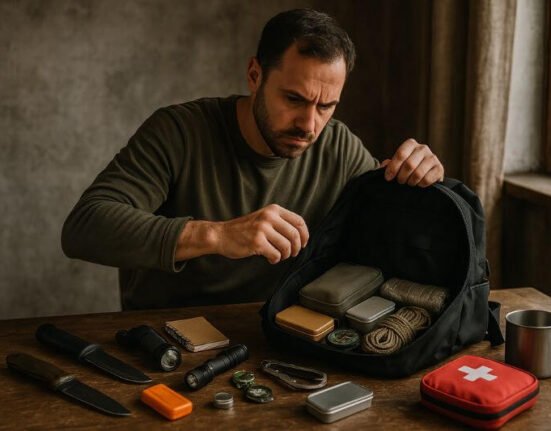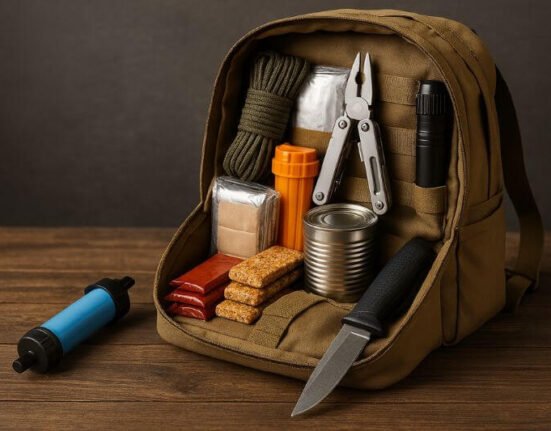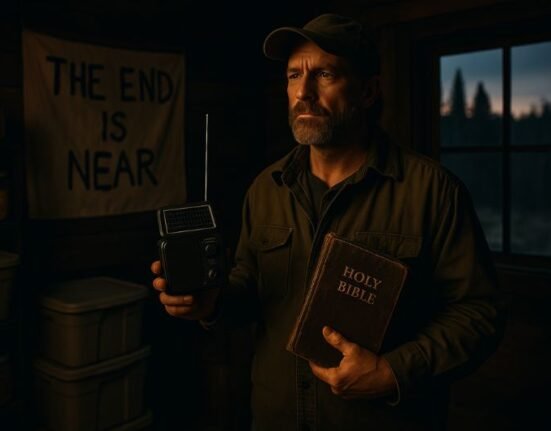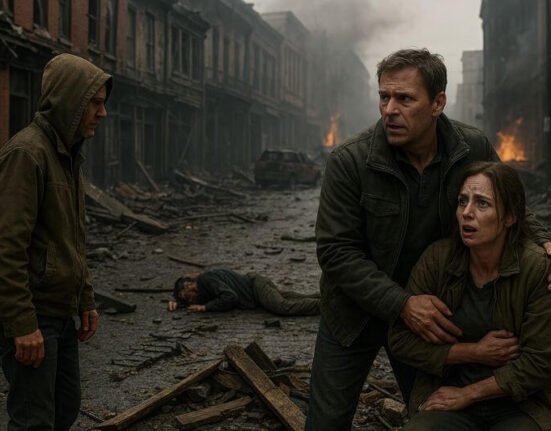When disaster strikes, complexity becomes your enemy. In the chaos of survival, it’s not your multitool, your solar panel, or even your tactical backpack that matters most—it’s the basics. Survival basics are the non-negotiable needs every human must meet to stay alive: water, shelter, fire, and food.
No matter the scenario—urban blackout, wilderness isolation, natural disaster, or societal collapse—these four elements define your odds. If one of them fails, your timeline to danger shortens rapidly. In this first section, we’ll break down why these four basics matter, how quickly your body starts to fail without them, and how to think about priorities in any survival situation.
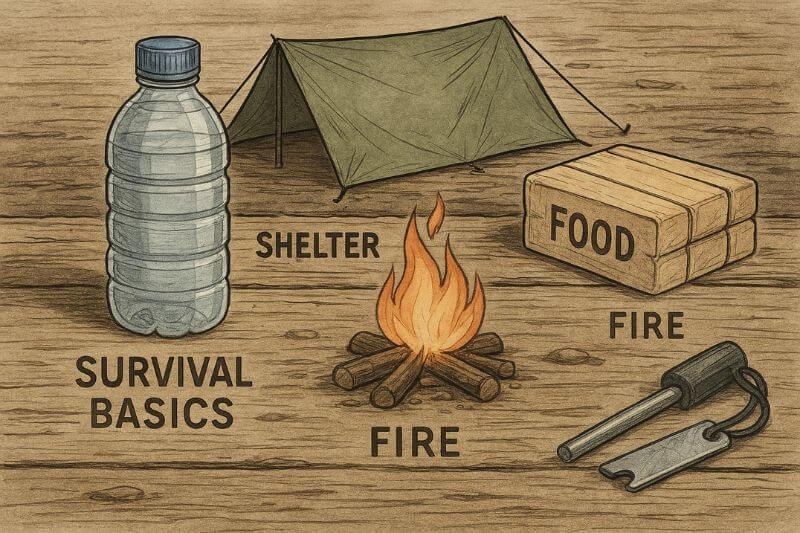
🕒 The Rule of Threes: Understanding Survival Time Limits
To grasp the importance of the basics, survival experts use a foundational guideline called the Rule of Threes:
| Resource | Survival Limit | Example Scenario |
|---|---|---|
| Air | 3 minutes | Smoke inhalation in fire |
| Shelter | 3 hours in extreme weather | Freezing storm, desert heat |
| Water | 3 days | Stranded without access |
| Food | 3 weeks | Long-term disruption or isolation |
This hierarchy reveals something critical: you don’t die of hunger first—you die of exposure or dehydration.
🎯 The survival basics aren’t just about what to pack—they’re about knowing what to protect first.
💧 Water: Your Body’s Top Priority (After Air)
Water is your lifeline. It regulates temperature, supports brain function, and keeps your organs alive. But in a crisis, clean water is often the first thing to disappear.
✅ How Fast Does Dehydration Hit?
- After 12 hours without water: you lose focus and energy
- After 24–36 hours: headaches, dizziness, confusion
- After 72 hours: organ damage and risk of death begin
⚠️ In hot environments, this timeline speeds up dramatically.
🛠️ Practical Tips for Securing Water:
- Always carry a compact filter (e.g. LifeStraw or Sawyer Mini)
- Boil water when possible (10 min for full kill)
- Use purification tablets if fire isn’t an option
- Know how to collect rainwater and build solar stills
🧠 Psychological Bias:
Many people underestimate how much water they actually need, especially when sweating, moving, or panicking. That’s why your gear should reflect preemptive logic, not hopeful optimism.
🏕️ Shelter: Protection From the Real Killers—Cold, Heat, and Wind
Shelter is often ignored by beginners who obsess over tools or food. But in most survival deaths, exposure is the real cause—not lack of calories.
🌡️ The Threats:
- Hypothermia: Can occur at just 10°C with wind and wet clothing
- Hyperthermia: Heatstroke can kill within hours
- Rain + Wind: Accelerate core temperature loss
✅ Shelter Essentials:
- Emergency bivvy or tarp: Lightweight, compact
- Clothing layers: Wool, synthetic, no cotton
- Insulation from ground: Sleeping pad, pine boughs, clothing
- Windbreaks + shade setups: Use landscape features or tarp angles
🧠 Survival Psychology Insight:
When under stress, people often keep moving instead of building shelter, believing “I can push through.” But once cold or heat set in, your energy drops—fast.
🔥 Fire: Heat, Signal, Morale, and Survival Multiplier
Fire isn’t just warmth. It’s protection, purification, comfort, and a tool for cooking. But it’s also a skill—not just a lighter in your bag.
🔥 Functions of Fire in Survival:
- Boil water to kill bacteria
- Warmth in cold environments
- Cook food and improve nutrition
- Dry wet clothes or gear
- Signal rescuers with light or smoke
- Create psychological safety (reduces panic and isolation)
✅ Fire Basics to Pack and Practice:
- Two fire-starting methods minimum:
- Ferro rod + cotton + Vaseline
- Waterproof matches
- Bic lighter (stored safely)
- Tinder source: dryer lint, birch bark, fatwood
- Practice ignition in wind, wet, dark conditions
🔥 If you haven’t practiced making fire with wet hands, tired eyes, and wind at your back, you’re not ready yet.
🍞 Food: Fueling the Body and Mind Long-Term
Food may not be your first survival priority, but it becomes critical after day 2. Hunger affects your mood, energy, and ability to think clearly. In long-term crises, food security separates survivors from victims.
🧠 Psychological Importance:
- Eating regularly preserves mental function
- Shared meals boost morale in group survival
- Warm food provides emotional anchoring in chaos
✅ Survival Food Essentials:
- High-calorie, low-prep options (energy bars, trail mix, MREs)
- Long shelf life: freeze-dried or vacuum-packed
- Portable and water-efficient foods (no excessive boiling)
- Include comfort food for morale (sugar, chocolate, tea)
🔄 The Survival Prioritization Loop
When faced with a survival situation, your brain should run this loop:
- Am I exposed to temperature extremes? → Shelter
- Do I have clean water? → Filter or purify
- Can I make fire now, before dark or cold?
- What’s my food access in the next 48 hours?
This isn’t instinct—it’s trained mindset. And when the world spins out of control, trained instinct is everything.
How Survival Basics Work Together—and What Happens When One Fails
Now that we’ve broken down the four survival basics—water, shelter, fire, and food—it’s time to connect the dots. In real-world emergencies, these elements don’t exist in isolation. They’re part of a dynamic system, where one strengthens—or compromises—the others.
The survivalist who thrives is the one who understands how these basics interact, and what to do when one of them breaks down.
🔄 The Interdependence of the Basics
Let’s visualize a scenario:
You’re stranded in a forest. It’s raining. You’re tired, it’s 4°C, and night is falling.
Here’s how the basics interplay:
- Shelter without fire = hypothermia risk
- Water without fire = contaminated supply
- Food without water = digestion issues, dehydration
- Fire without shelter = smoke exposure or extinguishment
- No shelter or water = rapid exhaustion and death within 24–48h
Survival is not linear—it’s synergistic. Each basic protects the others, and when one fails, the rest are forced to compensate—usually with energy you don’t have.
🧠 What Happens When You Ignore Just One Basic?
Here’s what it looks like when one of the four is missing or underestimated:
1. No Shelter
Consequences:
- Body heat loss → decreased energy, decision fatigue
- Increased exposure to insects, rain, wind
- Mental breakdown due to lack of rest and protection
Example:
- A beginner builds a fire but sleeps on cold, wet ground → severe chills and illness
2. No Water
Consequences:
- Quick onset of brain fog and irritability
- Inability to process food = energy crash
- Risk of kidney failure or heatstroke
Example:
- Urban prepper has 3 days of food but no purification tools. Flood hits. Water sources are all contaminated.
3. No Fire
Consequences:
- Water remains unsafe
- Cold food = reduced morale and digestion
- No signal = isolation
Example:
- Hiker brings freeze-dried meals, but no way to boil water → starves despite carrying 10,000 calories
4. No Food
Consequences:
- Reduced mobility, slower thinking
- Dangerous shortcuts (eating unsafe plants, poor decisions)
- Weakness = vulnerability
Example:
- Bug out kit has gear and fire, but no calorie-dense food → physical decline starts on Day 2
🎯 When your body starts failing, your judgment goes with it. That’s when real survival collapses.
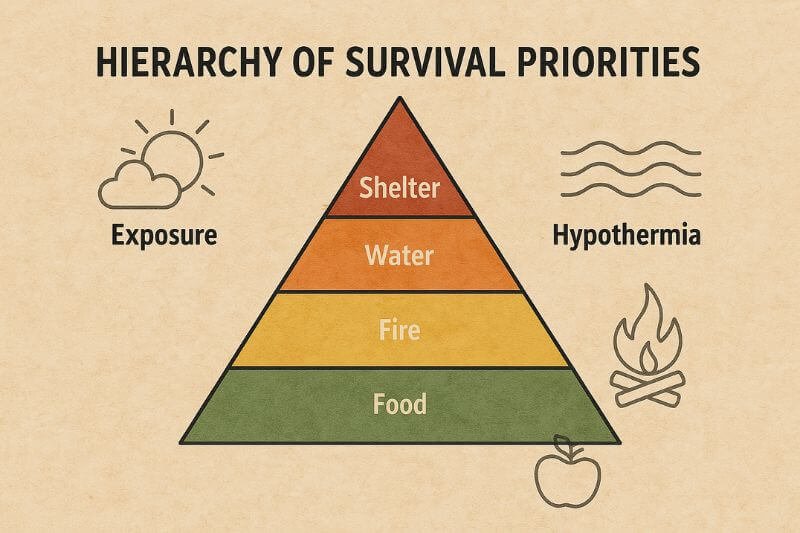
🧰 Building a Balanced Kit Around the 4 Basics
To survive, your gear must reflect these priorities—not YouTube hype or influencer checklists. Here’s how to build a 72-hour survival kit around the 4 basics:
✅ Water Module
- Collapsible water bottle (1–2L)
- Filter straw or inline purifier
- Water purification tabs (backup)
- Ziplock bag (can function as solar still liner)
Bonus: small metal cup for boiling
✅ Shelter Module
- Tarp + paracord (10m+)
- Mylar emergency bivvy or sleeping bag liner
- Foldable sleeping mat or inflatable pad
- Rain poncho (doubles as windbreaker)
Bonus: plastic sheet for ground insulation
✅ Fire Module
- Ferro rod with striker
- Bic lighter + waterproof case
- Tinder (fatwood, cotton/Vaseline, dryer lint)
- Mini stove + solid fuel cubes (optional)
Bonus: magnifying lens or candle stub for redundancy
✅ Food Module
- 6–9 high-calorie energy bars
- Trail mix, jerky, dry crackers
- Freeze-dried pouch meals (if you have heat source)
- Electrolyte tabs (prevent cramps, brain fog)
Bonus: collapsible spork + salt packets (morale boost)
🧠 Everything else—tools, radios, gadgets—are bonuses. These four modules are survival.
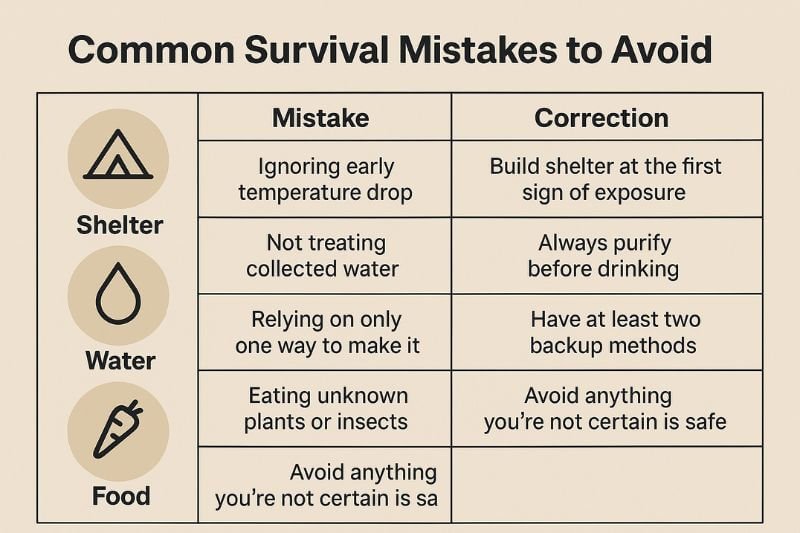
❌ Common Mistakes That Compromise Survival Basics
Even experienced preppers fall into traps. Here’s what to avoid:
🚫 Mistake 1: “Too Much Tool, Not Enough Basics”
- Fancy gear with no shelter or food plan
Fix: Pack backward—start with survival timeline, not cool items.
🚫 Mistake 2: “Assuming Nature Will Provide”
- Thinking you can “find” water or food in the wild
Fix: Nature isn’t a vending machine. Always carry your basics.
🚫 Mistake 3: “Food Obsession, No Fire”
- Packing 3 days of food, but no heat to cook it
Fix: Prioritize fuel-efficient, no-cook options first.
🚫 Mistake 4: “Static Thinking”
- Building one kit for all situations
Fix: Create modular kits for different risks (urban, forest, vehicle)
🚫 Mistake 5: “No Testing, No Practice”
- Never using your gear until the real crisis
Fix: Test your survival basics in the field. Build the fire. Boil the water. Sleep in the shelter.
🔥 What you don’t practice, you don’t retain. Survival is not theoretical.
🧭 Prioritizing in the Field: What to Do First
Let’s say the worst happens. You’re stranded, alone, and have your gear. What do you do?
Follow this field-tested survival priority map:
| Step | Action | Why it Matters |
|---|---|---|
| 1 | Assess environment (weather, terrain) | Guides shelter setup & risk level |
| 2 | Build shelter before nightfall | Protects from exposure, preserves heat |
| 3 | Find & purify water before dark | Night = higher dehydration risk |
| 4 | Build fire (if cold or water needs boiling) | Keeps you alive and calms the mind |
| 5 | Eat light, hydrate, stay warm | Prevents energy crash overnight |
🎯 Prioritization saves lives. Reaction gets people killed.
From Knowledge to Instinct: Mastering Survival Basics for Life
Knowing the survival basics—water, shelter, fire, food—is one thing. But to truly thrive in a crisis, this knowledge must become second nature. Whether you’re preparing for a hurricane, a civil breakdown, or just a three-day hike gone wrong, mastery means you can teach it, adapt it, and live it under pressure.
This final section will show you how to embed the basics into your life, teach them to others (including kids), and adapt them for every environment—from skyscrapers to snowy forests.
🧠 Why Instinct Beats Intelligence in Survival
When everything falls apart, you won’t have time to think. You’ll act.
- Stress reduces cognition by up to 60%
- Fine motor skills degrade
- Panic overrides plans
That’s why survival isn’t about memorizing facts—it’s about creating automatic responses through training, habits, and environmental awareness.
🎯 The more automatic your survival priorities become, the more energy you save for real decisions.
👨👩👧 Teaching Survival Basics to Your Family and Team
A kit helps. A trained person helps more. A trained group? That’s real resilience.
Here’s how to teach the four basics effectively:
💧 Teaching Water Priority
Goal: Help others understand how quickly dehydration becomes a threat.
How to teach it:
- Use a “water awareness” challenge: Go 6 hours outdoors with only 1 liter and observe performance.
- Practice water purification with kids (LifeStraw demo, boiling game).
- Create a “find the cleanest source” scavenger hunt with maps.
🧠 Tip: Turn training into a family challenge. Give points for fastest purification, best collection method, or filter memory.
🏕️ Teaching Shelter First Mindset
Goal: Build urgency around protection from the elements.
How to teach it:
- Simulate a storm: “You have 10 minutes to build shelter with only this tarp and paracord.”
- Night test: Sleep one night outdoors with just a bivvy and sleeping pad
- Teach ground insulation using leaves, clothing, and forest debris
🎯 Have them experience cold or discomfort in a safe, supervised way—it builds lasting memory.
🔥 Teaching Fire as More Than Warmth
Goal: Help others understand fire as a survival multiplier.
How to teach it:
- Practice starting a fire in wind or after soaking tinder
- Assign fire roles in a group: spark, fuel, protection, watch
- Teach signaling: 3 smoke puffs = distress
🧠 Kids and teens love fire drills—make it about responsibility, not just survival.
🍞 Teaching Food as Fuel and Morale
Goal: Show how food supports mental strength and stamina.
How to teach it:
- Blind test calorie efficiency: “Which snack gives the most fuel?”
- Practice “no-cook” day: sustain on survival bars and trail mix
- Pack shared “comfort rations”: small chocolate, tea, sugar
💬 Food in crisis isn’t just nutrition—it’s sanity.
🌎 Adapting the Basics to Different Environments
Each environment changes how you implement the basics. Let’s break down key adaptations for the four main survival contexts:
🏙️ Urban Survival (Blackouts, Riots, Infrastructure Collapse)
Water:
- Locate alternative sources: toilet tanks, water heaters, roof tanks
- Store water in hidden/secure containers
Shelter:
- Use blackout materials to block windows (heat/cold)
- Identify secure interior zones (no glass, few entry points)
Fire:
- Indoor-safe options: candle heaters, alcohol stoves
- Know ventilation risks: never use gas heating in sealed space
Food:
- Focus on canned goods, minimal-cook meals
- Secure food from looting risk or power outages
🌲 Forest & Wilderness Survival
Water:
- Prioritize moving sources (streams > ponds)
- Know terrain to find collection spots (valleys, rock pools)
Shelter:
- Lean-to, tarp tents, or debris huts
- Use natural insulation (leaves, moss)
Fire:
- Use wet-weather techniques: dry tinder under bark, carry fire-starters
- Practice long burns with minimal fuel
Food:
- Learn 3–5 safe wild edibles only if well trained
- Don’t rely on foraging—pack reliable calories
❄️ Cold-Climate Survival
Water:
- Melt snow safely (avoid yellow/dirty snow)
- Always boil: frozen water may carry bacteria
Shelter:
- Block wind first, then insulate
- Dig snow shelters only with experience (risk of collapse)
Fire:
- Fuel use increases drastically—gather double what you think
- Keep lighters close to the body (cold kills spark)
Food:
- Fatty, high-calorie foods (jerky, ghee, nuts)
- Heat food before eating to preserve body temperature
☀️ Desert or Arid Survival
Water:
- Collect dew, use solar stills
- Carry water at all times—never rely on finding it
Shelter:
- Prioritize shade during the day, wind at night
- Bury part of body during heat peaks if needed
Fire:
- Used mainly for signaling, not heat
- Dry fuel everywhere—fire spreads fast: safety first
Food:
- Low-water consumption snacks
- Electrolyte tablets to offset sweat loss
🌀 Make Survival Basics a Lifestyle, Not a Panic Response
Don’t wait for disaster to start living like a survivor. Integrating the basics into daily life is the best way to stay ready without stress.
🧰 Everyday Ways to Practice Survival Basics
| Basic | Practice Method |
|---|---|
| Water | Rotate stored water monthly, carry bottle + tabs |
| Shelter | Camp with minimal gear once per season |
| Fire | Light a fire in rain or snow once a month |
| Food | Do one “72h meal plan” quarterly |
🔄 Long-Term Mindset Shift
- Teach, test, rotate—make it family culture
- Don’t chase perfection—chase readiness
- Keep gear modular, not bloated
- Use your gear. Update your gear. Know your gear.
Final Reflection: Survival Is Simplicity Mastered
In the end, survival basics are not complicated—but they are essential.
Most people fail in crisis not because they lack tools—but because they neglected the four pillars that every human depends on:
- Without shelter, cold or heat defeats you
- Without water, the body shuts down
- Without fire, everything slows and darkens
- Without food, your strength fades
🧠 The mind that masters these four—calmly, habitually, and intelligently—is the mind that survives.
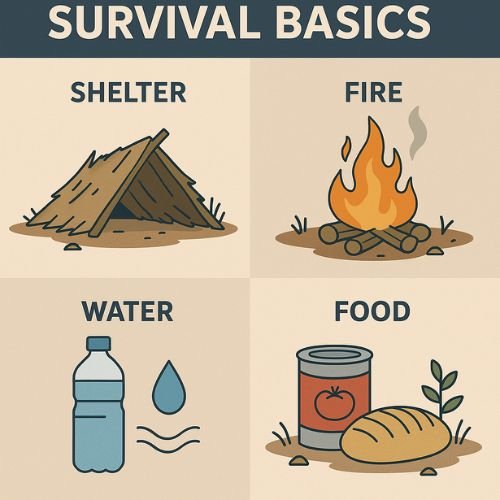
❓ Frequently Asked Questions (FAQ)
Q1: What exactly are the survival basics, and why do they matter more than gear or weapons?
The survival basics refer to four essential needs that every human must meet to stay alive in any crisis: water, shelter, fire, and food. These are rooted in biology, not tactics. Your body needs hydration, temperature regulation, caloric energy, and protection from exposure to function.
Without them:
- You can die from hypothermia in 3 hours
- Dehydration kills in 3 days
- Starvation impacts decision-making after 48–72 hours
Gear and weapons can help—but without the basics, you won’t last long enough to use them effectively. That’s why mastering survival basics is the foundation of any prepping plan.
Q2: How can I remember what to prioritize when everything feels urgent in a survival situation?
Use the Rule of Threes and a mental checklist called the Survival Loop:
Rule of Threes:
- 3 minutes without air (panic, smoke, drowning)
- 3 hours without shelter (cold/heat exposure)
- 3 days without water
- 3 weeks without food
Survival Loop (in order):
- Shelter (protect your core temperature)
- Water (hydrate or purify)
- Fire (warmth, signaling, water purification)
- Food (energy maintenance)
If you’re overwhelmed, start with the environment:
➡️ “Can I survive 12 hours here without dying of cold or dehydration?”
Let that answer guide what you do first.
Q3: What’s the most common mistake beginners make when preparing for the survival basics?
They overprepare the wrong things, and underprepare the basics.
Typical errors include:
- Packing too much food, but no firestarter
- Bringing a tent but no ground insulation
- Carrying electronics but forgetting a water filter
- Focusing on weapons instead of shelter and heat
Another big mistake? Relying on store-bought “survival kits” without understanding the logic behind what’s inside.
💡 The best survival kits are built around the four basics—everything else is optional.
Q4: How do I teach survival basics to children or beginners without overwhelming them?
Use the “See It, Do It, Feel It” method:
- See It: Show what each basic looks like in real life (e.g. tarp shelter, filtering water)
- Do It: Let them practice setting up, filtering, starting a fire, or choosing food
- Feel It: Let them experience mild discomfort (cold, limited water, hunger) in safe environments—so the lessons stick
Tips:
- Turn it into a game or challenge
- Create a “Survival Basics” badge chart
- Reward smart decisions, not gear hoarding
The key is to make survival knowledge feel empowering, not fearful.
Q5: How can I adapt survival basics to urban environments, where I don’t have wilderness gear or nature around me?
Urban survival still follows the same four pillars—but implementation is different:
- Water: Store tap water in bottles, use water heaters/toilets as backup, have purification tablets for unknown sources
- Shelter: Secure internal rooms away from glass/windows, insulate with blankets or blackout curtains, stay above street-level unrest
- Fire/Heat: Use candles, alcohol stoves, or body heat (with ventilation), keep lighters and matches stored safely
- Food: Prioritize no-cook meals (canned beans, tuna, crackers), and rotate your pantry regularly
Urban environments come with different threats (looting, building collapse, restricted movement), but the survival basics remain exactly the same—they just require creative adaptation.









